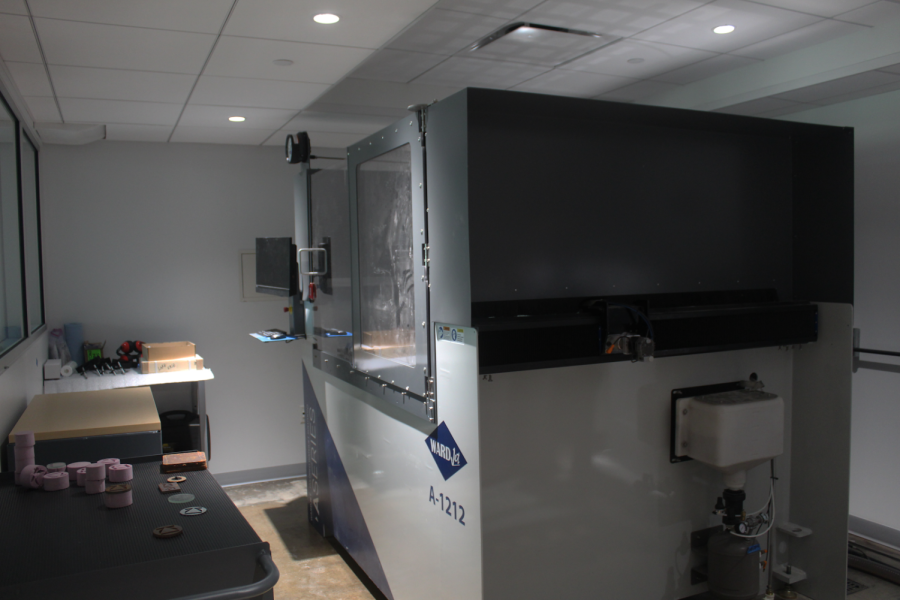DI Hub receives waterjet cutter, offers efficient process for cutting materials
The WARDJet A-1212 waterjet cutter sits on the first floor of the Design Innovation Hub. The device had to be installed first into the room before building crews erected the walls around it.
October 7, 2020
A robust industrial machine known as a waterjet cutter, which can slice through nearly any material with a pressurized stream of water, is located on the first floor of the Design Innovation Hub at Kent State. As Outreach Program Manager for Design Innovation Andrea Oleniczak fires up the device, sounds of building pressure emit from a pump as the water is pressurized, bringing the cutter alive as she demonstrates the transfer of power from the pump to the cutter. This technology is the first of its kind on Kent’s campus, and offers students and faculty an outlet to cut materials in an efficient and precise manner.
The four-by-four-foot cutter is an enclosed space, which allows the device to cut into any material and prevent water from spraying in multiple directions. Oleniczak said the device allows users to carve materials with a cleaner cut, as opposed to a laser cutter which may produce rougher cuts. Oleniczak said this particular model is an optimal choice for the education environment because of these safety features.
“The enclosure makes it a comfortable educational experience,” Oleniczak said, “especially for someone who’s never been on a waterjet cutter before. It can be a little intimidating on your first cut with the pressure and the sound and everything happening in the room, so that extra layer of being able to wrap around and have a front door enclosure was a really nice thought-out idea.”
Oleniczak said using water also provide the advantage of producing no toxic fumes, which laser cutters can produce when applying heat during a cut. While this model can only produce a vertical stream of water for cutting, Oleniczak said users can utilize the cutter’s simple cutting elements for projects and utilize other devices in the DI Hub like a milling machine for producing finer details.
JR Campbell, executive director for Design Innovation at Kent State, said the building’s design phase always incorporated a dedicated space for the cutter, as the machine required architects to find a space for the device to function without causing too much noise. Installing the cutter was also a factor, as the cutter had to be installed first before builders could frame the walls around it.
The cutter was purchased from local waterjet cutting manufacturer WARDJet, whose headquarters is centered in Tallmadge, Ohio. Campbell said the introduction of the cutter into the DI Hub is a slight nod towards the machinist community of Northeast Ohio, as the region holds a history and background related to these tools.
The waterjet cutter, like the majority of devices in the DI Hub, will be available to students and faculty who express an interest in using the device for projects. Trained student DI crews will be on hand to oversee the function of the cutter, which Oleniczak said is an essential element for safety standards.
“There will be a little bit of a gatekeeping situation so we won’t have someone come off the street and fire up the waterjet by themselves,” Oleniczak said. “We want to minimize that as much as possible in a safe manner to make sure that we are not putting any restrictions on someone with a creative idea and the actual tool.”
While DI Hub is still in the process of opening its facilities, students can anticipate using this device and other resources in the near future when student and faculty teams develop a process for inviting users into the makerspaces.
Troy Pierson is a reporter. Contact him at [email protected].
SUPPORT STUDENT MEDIA
Hi, I’m Lauren Sasala, a senior journalism student from Toledo. I’m also the editor in chief of The Kent Stater and KentWired this semester. My staff and I are committed to bringing you the most important news about Kent State and the Kent community. We are full-time students and hard-working journalists. While we get support from the student media fee and earned revenue such as advertising, both of those continue to decline. Your generous gift of any amount will help enhance our student experience as we grow into working professionals. Please go here to donate.

























